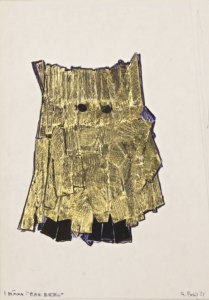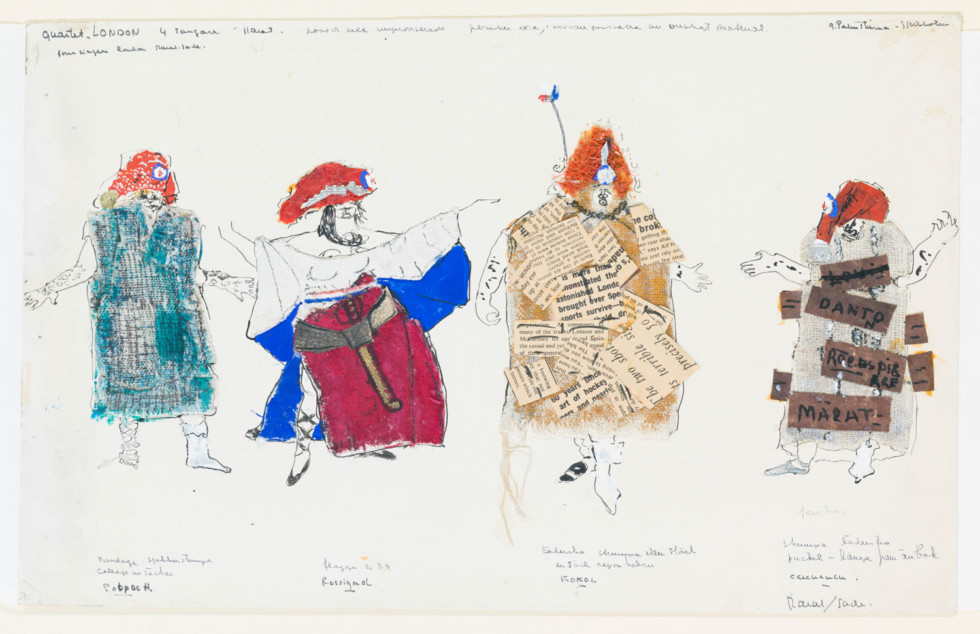ART-PRESENTATION: Gunilla Palmstierna-Weiss
 In the exhibition “Vivid Scenes 1964-1984” a selection of Gunilla Palmstierna-Weiss’ drawings, sketches and models are on presentation at Moderna Museet. Her artistic career began in stage design but branched in art. Her whole life was spent in the arts, and she was well connected in a transnational community of intellectually and politically engaged cultural workers when modern history was being written.
In the exhibition “Vivid Scenes 1964-1984” a selection of Gunilla Palmstierna-Weiss’ drawings, sketches and models are on presentation at Moderna Museet. Her artistic career began in stage design but branched in art. Her whole life was spent in the arts, and she was well connected in a transnational community of intellectually and politically engaged cultural workers when modern history was being written.
By Efi Michalarou
Photo: Moderna Museet Archive

Gunilla Palmstierna-Weiss is primarily known as a scenographer, but this multifaceted profession has many subcategories, two of which are drawing and architectural models. While stage design as a whole is a collective process of negotiation and collaboration, the actual sketching and model-making is a private and individual creative space. This is especially poignant her work: the drawings and models are meticulous, exuding a delight in the media, encapsulated in time, research and ideas. This exhibition presents her works in their own right, as solitaires – detached from the stage context. Her imagery is strongly influenced by the aesthetics of the Dutch De Stijl movement and the German Bauhaus school’s architectural program, both in the symbolic function of colors and the approach to stage design, where each object and detail must serve a purpose. These schools also propounded the idea of artistic mobility her practice crosses genres and disciplines, continuously interweaving art, crafts, technology and reflection. Her professional career began in the field of ceramics and sculpture, specialising on public embellishments, a practice she continued to pursue alongside her stage design. Apart from their aesthetic qualities, her drawings are deeply personal, expressing absurdism, lunacy, humor and darkness. In visual dramas, the individual characters perform grimaces, movements and physical ailments, along with collective situations where bodies build spaces in gatherings, armies and organisations. Gunilla Palmstierna-Weiss was born in Lausanne, Switzerland in 1928 and grew up in Vienna and Rotterdam before moving to Sweden while WWII raged in Europe. She studied at Tekniska skolan (now Konstfack) in Stockholm, the Gerrit Rietveld Academie in Amsterdam, and the École national supérieure des Arts Décoratifs in Paris, before embarking in 1952 on a long and successful collaboration with her partner, the artist Peter Weiss. Beginning with joint film production, she moved on in 1963 to work mainly with theatre. Together, the two became international key figures, both within the new radical left and in the emerging modern theatre movement. The couple also belonged to the circle of artists and creative workers at the centre of Moderna Museet and its activities that were emerging in the early 1960s. Her work on Peter Brook’s production of Marat/Sade first performed at the Royal Shakespeare Company in London, before going on to Broadway – won her a Tony Award for best costume design in 1966. The same year, she began collaborating with Ingmar Bergman on the production of Peter Weiss’ “The Investigation” for the Royal Dramatic Theatre in Stockholm, a professional partnership that continued for decades. In 2013, Gunilla Palmstierna-Weiss published her autobiography, the same year, Swedish Television SVT broadcast a documentary about h life in a male-dominerated industry.
Info: Curators: Emily Fahlén & Asrin Haidari (Mint), Moderna Museet, Skeppsholmen, Stockholm, duration: 30/3-29/9/19, Days & Hours: Tue & Fri 10:00-20:00, Wed-Thu 10:00-18:00, Sat-Sun 11:00-18:00, www.modernamuseet.se/stockholm



